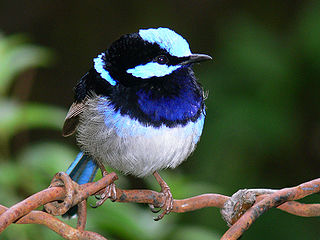
The Australasian wrens are a family, Maluridae, of small, insectivorous passerine birds endemic to Australia and New Guinea. While commonly known as wrens, they are unrelated to the true wrens. The family comprises 32 species in six genera.

The splendid fairywren is a passerine bird in the Australasian wren family, Maluridae. It is also known simply as the splendid wren or more colloquially in Western Australia as the blue wren. The splendid fairywren is found across much of the Australian continent from central-western New South Wales and southwestern Queensland over to coastal Western Australia. It inhabits predominantly arid and semi-arid regions. Exhibiting a high degree of sexual dimorphism, the male in breeding plumage is a small, long-tailed bird of predominantly bright blue and black colouration. Non-breeding males, females and juveniles are predominantly grey-brown in colour; this gave the early impression that males were polygamous as all dull-coloured birds were taken for females. It comprises several similar all-blue and black subspecies that were originally considered separate species.
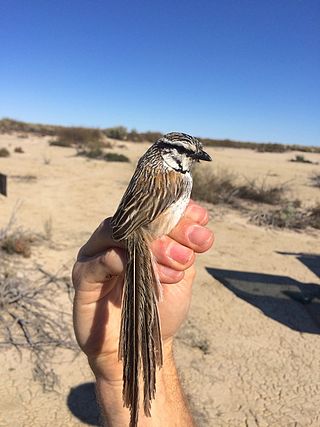
The grey grasswren is a passerine bird in the Australasian wren family, Maluridae. It is found on arid inland floodplains of Australia where it is endemic. The grey grasswren is a rarely seen elusive bird that was first sighted in 1921 but not taxonomically described until 1968. Its greyish coloration and very long tail distinguish it from all other grasswrens. While some recent research has been conducted, there still remain many gaps in the knowledge about the ecology of this cryptic bird.

Grasswrens (Amytornis) are a genus of birds in the Australasian wren family, Maluridae.

The Eyrean grasswren is a small grasswren from the Passerine family Maluridae. This is a cryptically plumaged and uncommon bird endemic to arid regions of Central Australia. The species was discovered by F.W. Andrews in 1874 around the Macumba River at Lake Eyre, and named after the South Australian Surveyor General George Woodroffe Goyder.
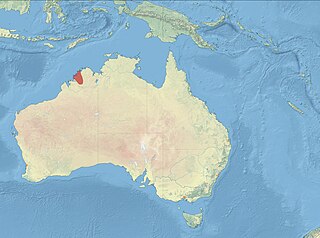
The black grasswren, known as dalal to the Wunambal people, is a species of bird in the family Maluridae. It is endemic to Western Australia.

The dusky grasswren is a species of small passerine bird in the family Maluridae. The species is endemic to Australia but is limited to inland areas of the Northern Territory, Western Australia and South Australia.
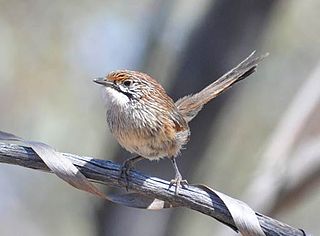
The striated grasswren is a small, cryptically coloured ground-dwelling species of wren-like bird in the family Maluridae, endemic to Australia. It occupies a large discontinuous range across arid and semi-arid areas of western, central and southern Australia where it is associated with spinifex (Triodia) grass.
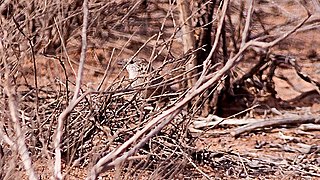
The thick-billed grasswren is a species of bird in the family Maluridae. It is endemic to Australia. Its natural habitat is Mediterranean-type shrubby vegetation.

The white-shouldered fairywren is a species of bird in the Australasian wren family, Maluridae. It is found in New Guinea.

The red-backed fairywren is a species of passerine bird in the Australasian wren family, Maluridae. It is endemic to Australia and can be found near rivers and coastal areas along the northern and eastern coastlines from the Kimberley in the northwest to the Hunter Region in New South Wales. The male adopts a striking breeding plumage, with a black head, upperparts and tail, and a brightly coloured red back and brown wings. The female has brownish upperparts and paler underparts. The male in eclipse plumage and the juvenile resemble the female. Some males remain in non-breeding plumage while breeding. Two subspecies are recognised; the nominate M. m.melanocephalus of eastern Australia has a longer tail and orange back, and the short-tailed M. m. cruentatus from northern Australia has a redder back.

The emu-wrens (Stipiturus) are a genus of passerine birds in the Australasian wren family, Maluridae. They are found only in Australia, where they inhabit scrub, heathland and grassland. They are small birds, 12–19 cm long with the tail accounting for over half of their length. The tail has only six feathers which are loose and coarse in structure, rather like the feathers of the emu. Three species are recognised, of which the mallee emu-wren is endangered.

The mallee emu-wren is a species of bird in the Australasian wren family, Maluridae. It is endemic to Australia.

The rufous-crowned emu-wren is a species of bird in the Australasian wren family, Maluridae. It is endemic to Australia.
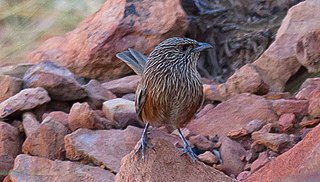
The Kalkadoon grasswren, also called the Ballara grasswren, is a species of passerine bird in the family Maluridae. It is endemic to Australia.
Leslie Christidis, also simply known as Les Christidis, is an Australian ornithologist. His main research field is the evolution and systematics of birds. He has been director of Southern Cross University National Marine Science Centre since 2009. He was assistant director at Sydney's Australian Museum from 2004 to 2009.
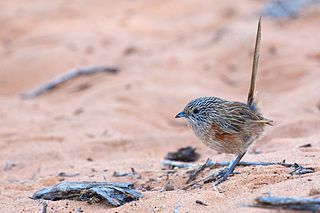
The western grasswren, formerly known as the textile wren, is a species of bird in the family Maluridae. It is endemic to Australia. It was formerly lumped as the nominate subspecies of the thick-billed grasswren.

Alexander William Milligan was an Australian accountant, legal clerk, zoological collector and ornithologist.

The purple-backed fairywren is a fairywren that is native to Australia. Described by Alfred John North in 1901, it has four recognised subspecies. In a species that exhibits sexual dimorphism, the brightly coloured breeding male has chestnut shoulders and azure crown and ear coverts, while non-breeding males, females and juveniles have predominantly grey-brown plumage, although females of two subspecies have mainly blue-grey plumage. Distributed over much of the Australian continent, the purple-backed fairywren is found in scrubland with plenty of vegetation providing dense cover.
The rufous grasswren or Pilbara grasswren is an insectivorous bird in the Australasian wren family Maluridae. It is found in Western Australia. It was formerly considered to be conspecific with the sandhill grasswren.

















